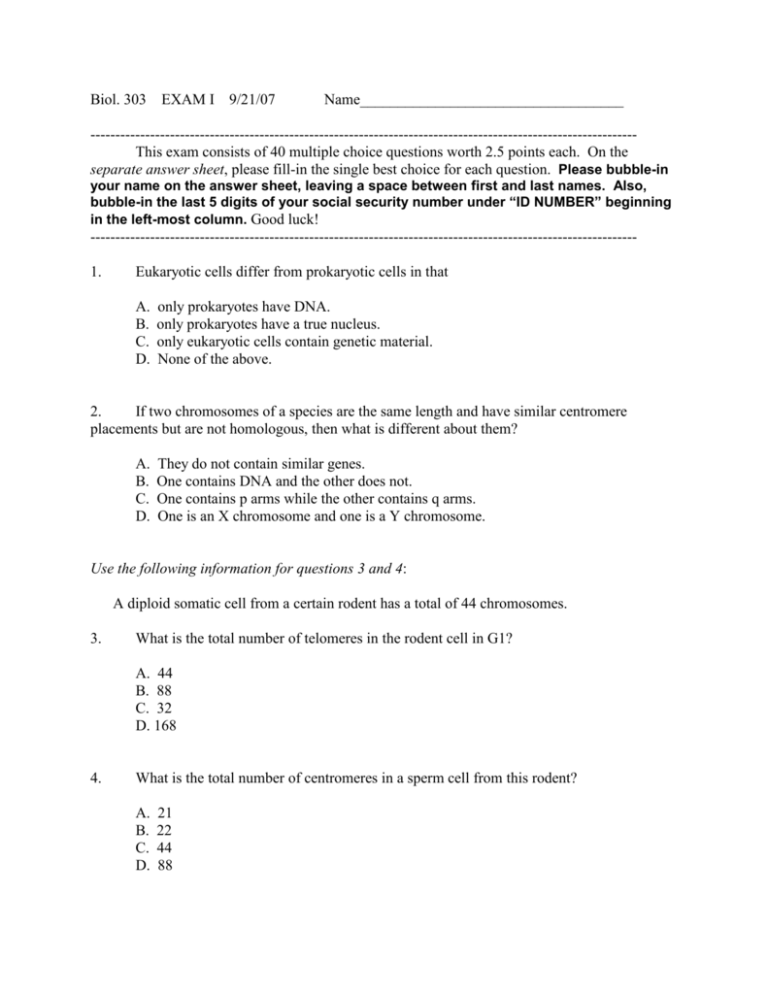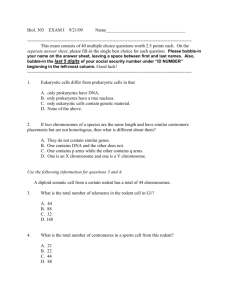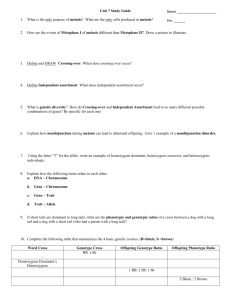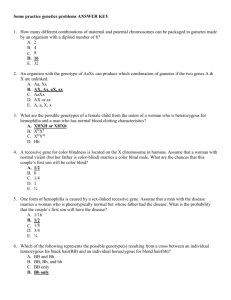EXAM 1-FALL07ANS
advertisement

Biol. 303 EXAM I 9/21/07 Name___________________________________ -------------------------------------------------------------------------------------------------------------This exam consists of 40 multiple choice questions worth 2.5 points each. On the separate answer sheet, please fill-in the single best choice for each question. Please bubble-in your name on the answer sheet, leaving a space between first and last names. Also, bubble-in the last 5 digits of your social security number under “ID NUMBER” beginning in the left-most column. Good luck! -------------------------------------------------------------------------------------------------------------1. Eukaryotic cells differ from prokaryotic cells in that A. B. C. D. only prokaryotes have DNA. only prokaryotes have a true nucleus. only eukaryotic cells contain genetic material. None of the above. 2. If two chromosomes of a species are the same length and have similar centromere placements but are not homologous, then what is different about them? A. B. C. D. They do not contain similar genes. One contains DNA and the other does not. One contains p arms while the other contains q arms. One is an X chromosome and one is a Y chromosome. Use the following information for questions 3 and 4: A diploid somatic cell from a certain rodent has a total of 44 chromosomes. 3. What is the total number of telomeres in the rodent cell in G1? A. 44 B. 88 C. 32 D. 168 4. What is the total number of centromeres in a sperm cell from this rodent? A. B. C. D. 21 22 44 88 5. A place in the eukaryotic cell cycle at which a "decision" is made whether to proceed through the cell cycle or to arrest cell cycle progression is generally known as A. B. C. D. 6. Which step of meiosis contributes to significant genetic variation? A. B. C. D. 7. S phase G1 phase a checkpoint mitosis None, since meiosis normally produces genetically identical cells. Telophase I Prophase I Metaphase II What is one difference between mitosis and meiosis? A. Meiosis involves two cell divisions while mitosis involves one. B. The products of mitosis are normally haploid. C. The products of meiosis are diploid D. Mitosis produces four cells, while meiosis produces two. 8. The term synapsis refers to A. B. C. D. 9. tight pairing of homologous chromosomes during meiosis. tight pairing of homologous chromosomes during mitosis. nondisjunctions none of the above. An allele is A. B. C. D. a type of cell. a dominant trait. a form of a gene. an imaginary concept. 10. What is the probability that in an organism with a haploid number of 12, an egg will be formed that contains all 12 chromosomes whose centromeres were derived from maternal homologs? A. B. C. D. (1/12)2 (1/10)12 (1/2)12 None of the above. 11. The figure below shows a chromosomal separation taking place. Little circles represent centromeres. The letters stand for genes; capital and lowercase stand for different alleles. 2n in this organism is 4. What process is shown? A. B. C. D. anaphase of mitosis telophase of meiosis I anaphase of meiosis I anaphase of meiosis II A A B C d b C d 12. In each of Mendel's monohybrid crosses of pea plants, the trait that appeared in the F1 generation A. B. C. D. illustrated the principle of independent assortment. disappeared in the F2 generation. appeared in 1/4 of the plants in F2 generation. was dominant. 13. In each one of Mendel's dihybrid crosses, A. B. C. D. simple dominance and recessivness was observed. the phenotypes in the F2 generation segregated in a 9:3:3:1 ratio. epistasis was not evident. all of the above. 14. In a cross between two plants of the following genotypes: (AaBb x AaBb), which one of the following genotypes should occur at the highest frequency among the offspring? A. B. C. D. 15. In the cross (AaBb x AaBb), the genotype AABb should occur at what frequency? A. B. C. D. 16. AaBb AABb AABB aabb 1/4 1/8 1/2 1/16 A 9:3:3:1 ratio of phenotypes in the F2 generation of a dihybrid cross A. holds true only for genes on the same chromosome. B. indicates that the dihybrid cross is basically equivalent to two independent monohybrid crosses. C. is not indicative of independent assortment. D. indicates that an epistatic relationship exists between the two genes under investigation. 17. The chi-square test involves statistical comparison between observed versus expected values. In a chi-square test, one does not reject the null hypothesis if A. B. C. D. p ≥ 0.05 p ≥ 5.0 p=q it is Friday 18. Albinism in humans is inherited as a simple recessive trait. Two normal parents have five children and one is albino. The genotypes of the parents can be: A. B. C. D. ♀ = AA ♀ = AA ♀ = aa ♀ = Aa ♂= ♂= ♂= ♂= Aa aa aa Aa ♀ = mom ♂ = dad 19. A tall, violet plant is crossed with a dwarf, white plant and all of the F1 offspring are tall, violet. The F1 plants are selfed to produce the F2 generation. What fraction of the F2 generation would you expect to be dwarf, white? (Assume independent assortment.) A. B. C. D. 1/4 9/16 3/16 1/16 20. How many different types of gametes can be formed by an individual of the following genotype: AaBbCcDdEe? A. B. C. D. 1 5 25 = 32 52 = 25 21. A male cat has short hair, a stubby tail, and extra toes. A female cat has long hair, a long tail, and extra toes. The genes and alleles are as follows: L = short hair; l = long hair M = stubby tail; m = long tail P = extra toes; p = normal number of toes The two cats have kittens. One kitten has long hair, a long tail, and no extra toes. What is the genotype of the father? A. B. C. D. LL MM PP Ll Mm PP ll mm pp Ll Mm Pp 22. Red-green color blindness is X-linked recessive. A color-blind woman has a child with a man having normal vision. Which statement is correct? A. B. C. D. All daughters should be colorblind. No daughter should be colorblind 50% of sons should be colorblind None of the above. 23. Consider three independently assorting genes A, B, and C. What is the probability of obtaining an offspring that is AABbCc from parents that are AABbCc and AaBbCc? A. 1/8 B 1/4 C. 1/16 D. 1/32 24. Consider the following pedigree: The trait depicted in the above pedigree is likely: A. B. C. D. autosomal recessive sex-linked recessive autosomal dominant sex-linked dominant 25. In the above pedigree, what is the genotype of the individual pointed out? (The relevant gene has alleles A and a.) A. B. C. D. AA Aa aa Can’t tell 26. A woman and a man are both heterozygous for freckles, which is the dominant condition. If they have one child, what are the chances that it will not have freckles? A. 25% B. 50% C. It will depend on the sex of the child. D. 75% 27. For the pedigree shown below: which one of the following modes of inheritance can be ruled out? A. B. C. D. 28. X- linked dominant X linked recessive Autosomal dominant All of the above are possible. Shown below is a pedigree for the rare autosomal recessive disease called Tay-Sachs: genotype Tt? Consider the woman who is pointed out in the pedigree. If the gene responsible for Tay-Sachs disease can be symbolized by alleles T and t, what is the probability that the woman’s genotype is Tt? A. 1/4 B. 1/2 C. 2/3 D. No chance, because she must be TT 29. With incomplete dominance, a likely F2 phenotypic ratio in a monohybrid cross would be: A. 3:1 B. 1:2:2:4 C. 1:2:1 D. 9:3:3:1 30. The difference between incomplete dominance and codominance is A. Nothing, they are the same B. Only incomplete dominance involves heterozygotes displaying a blending of phenotypes C. Only codominance involves heterozygotes with a blending of phenotypes D. Codominance produces classic Mendelian ratios while incomplete dominance does not. 31 A condition in which one gene influences the expression of another gene is called A. codominance. B. dominance. C. recessiveness. D. epistasis. 32. be? If a child is blood type A and the mother is blood type B, what blood type must the father A. B. C. D. A B A or AB O 33. Suppose that an allele, b, of a sex-linked gene is recessive and embryonic lethal. A man marries a woman who is heterozygous for this gene. If this couple had a large number of normal children, what would be the predicted ratio of male children to female children? A. B. C. D. 1:1 1:2 2:2 1:4 34. In “sex-influenced inheritance,” A. B. C. D. 35. When two genes fail to assort independently, the term normally applied is A. B. C. D. 36. a trait can be expressed in one sex only. a given genotype produces a different phenotype in males versus females. a given trait is on the X chromosome. fathers never pass the trait to sons. Mendelian inheritance. linkage. incomplete dominance. complementation. Which statement is true? A. two genes on the same chromosome can never assort independently from one another. B. two genes on different chromosomes will assort independently from one another. C. recombination will occur between a given pair of linked genes every time gametes are formed. D. two genes on the same chromosome will always appear to be genetically linked to one another in a dihybrid cross. 37. The recombination frequency between linked genes A and B is 40%, between B and C is 20%, between C and D is 10%, between C and A is 20%, and between D and B is 10%. What is the sequence of the genes on the chromosome? A. B. C. D. A B A A B A D C C D C D D C B B 38. In a typical three factor cross between a heterozygous female and a homozygous recessive male, offspring arising from double-crossover gametes will be A. B. C. D. the most common offspring the least common offspring females only problem children 39. A female fruit fly heterozygous for three linked mutant alleles a,b,c, (genotype AaBbCc) is crossed with a male fly that is homozygous recessive for all three mutant alleles. If the phenotypes of the most common offspring are ABc and abC, and the least common offspring are ABC and abc, then the order of the genes a b c on the chromosome is: A. B. C. D. abc bac bca not enough information to tell. 40. Consider the following table of data from a synteny test using mouse/human hybrid cells for assigning genes to human chromosomes. -----------------------------------------------------------------------------------hybrid human chromosomes human gene product cell: present: present: I 1 2 3 4 5 6 A B II 1 3 4 7 8 9 A B C III 1 2 7 8 A -----------------------------------------------------------------------------------Based on the above data, the gene that produces product C is located on human chromosome number: A. 1 B. 2 C. 9 D. can't tell. Good, I’m done. Now I can go “pea.” EXAM I Answer key Q:1,2,3,4,5,6,7,8,9,10,11,12,13,14,15,16,17,18,19,20,21,22,23,24,25,26,27,28,29,30,31,32, A:D,A,B,B,C,C,A,A,C, C, D, D, D, A, B, B, A, D, D, C, D, B, A, C, B, A, B, C, C, B, D, C, Q: 33,34,35,36,37,38,39,40 A: B, B, B B, D, B, C, C








